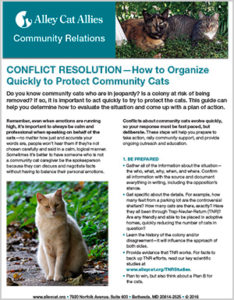Do you know community cats who are in jeopardy? Is a colony at risk of being removed? If so, it is important to act quickly to try to protect the cats. This guide can help you determine how to evaluate the situation and come up with a plan of action.
Remember, even when emotions are running high, it’s important to always be calm and professional when speaking on behalf of the cats. No matter how just and accurate your words are, people won’t hear them if they’re not chosen carefully and said in a calm, logical manner. Sometimes it’s better to have someone who is not a community cat caregiver be the spokesperson because they can discuss and negotiate facts without having to balance their personal emotions.
Conflicts about community cats evolve quickly, so your response must be fast paced, but deliberate. These steps will help you prepare to take action, rally community support, and provide ongoing outreach and education.
1. BE PREPARED
- Gather all of the information about the situation the who, what, why, when, and where. Confirm all information with the source and document everything in writing, including the opposition’s stance.
- Get specific about the details. For example, how many feet from a parking lot are the controversial shelters? How many cats are there, exactly? Have they all been through Trap-Neuter-Return (TNR)? Are any friendly and able to be placed in adoptive homes, quickly reducing the number of cats in question?
- Learn the history of the colony and/or disagreement; it will influence the approach of both sides.
- Provide evidence that TNR works. For facts to back up TNR efforts, read our key scientific studies at www.alleycat.org/TNRStudies.
- Plan to win, but also think about a Plan B for the cats.
2. TAKE ACTION
- Identify and contact the decision makers. These may include property managers, animal control officers, elected officials, public health officials, etc. An engaged and proactive approach increases the likelihood of a swift and positive response.
- Be clear with your requests, and document them in writing.
- Remain calm, polite, professional, and constructive in all of your dealings. Make sure all comments are objective and grounded in truth.
- Don’t try to reach an agreement about everything all at once. Break things down into smaller pieces with multiple decision points. For example, start by asking for a moratorium on trap-and-remove until a specified date to give all interested parties time to speak and work toward a solution they can all agree on.
3. USE THE POWER OF PEOPLE
- Garner support from the public and alert your own contacts. Even a list of 50 of your friends and community members is a good place to start for a supporter base. Social media is another easy way to engage the public.
- Contact all potential players, including local animal groups and Feral Friends (www.alleycat.org/ FindFeralFriends). Ask local advocates to help educate and persuade decision makers.
- Encourage all supporters to work as a team and focus on being a united front. Once people know of the problem, rally them to use public pressure to your advantage.
- Reach out to the media. Contact your local newspaper and television stations and let them know you have a story. Be truthful when reporting about the circumstances, but highlight details that will tug at people’s heart strings. Public sentiment in your favor is a powerful campaign tool. Remember to be cautious and don’t get discouraged; there’s no guarantee that media reports will favor your side, no matter how compelling your story is.
- Always be polite and rational and tell the same to your supporters. Over-excited and emotional responses may threaten your credibility, so be sure to carefully curate your message. Prepare a concise soundbite–what can you say in 10 seconds to summarize your point of view? Focus on the solution you are offering that will remedy the situation at hand.
- For additional advice on how to engage supporters and resolve issues peacefully, visit our Community Relations Resource Center at www.alleycat.org/CommunityRelations.
4. NEGOTIATE FOR A WIN
- Maintain a healthy dialogue with your opponents at all times. Be assertive when necessary, but never hostile.
- Be a good listener and do not cut your opponent off. Listen for the specific complaints; they might be resolved by a small change. For example, maybe feeding stations can be built and placed in a more discreet area, thereby reducing visibility of the cats from a business’s perspective.
- Be clear about the goal: to help the community and the cats through targeted TNR.
- Do your best to provide answers to problems and issues, but do not overcommit yourself or promise something you can’t deliver.
- Be a leader. Use your experience, the information you’ve gathered, and educational materials about TNR to present yourself as the expert on the issues. Your knowledge of local matters and of cats is a key to success.
- Document, in writing, all your efforts to show the level of help that you have provided and ensure both you and the cats are protected.
- Remember, it is very common for people to change their minds. Often those who want the cats removed do not realize the likely outcome for the cats is death. Once they do, they might decide they would rather the cats’ lives be saved.
5. HELP YOUR COMMUNITY AND CATS TO LIVE SIDE BY SIDE
- Become a part of the neighborhood, making connections and being recognized by residents.
- Provide ongoing and easy channels for communication. Ensure each voice is heard and listened to thoroughly.
- Take preemptive steps to help avoid any future concerns altogether. Ensure feeding stations and shelters are appropriately placed and well-tended, and install humane deterrents and repellents to encourage the cats to stay away from areas where they are not welcome.
- Find best practices for community cat colony care at www.alleycat.org/BestPractices.
More Information:
- Read key scientific studies on TNR at www.alleycat.org/TNRStudies.
- Get help from the Feral Friends Network at www.alleycat.org/FindFeralFriends.
- Visit our Community Relations Resource Center at www.alleycat.org/CommunityRelations.
- Find additional information on community cat care at www.alleycat.org/CareForCats.
- For more detailed information, including talking points and sample letters, refer to our Advocacy Toolkit at www.alleycat.org/AdvocacyToolkit.


